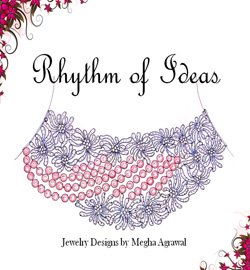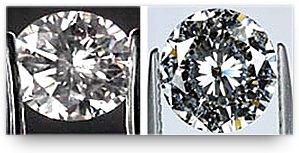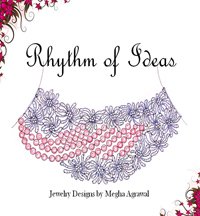Diamond Clarity Grading System
Clarity Grading Systems of diamond - Here I'll give you an overview of
different clarity grading systems and as a grader what one should keep in mind
at the time of clarity grading of diamond.
Flaws and inclusions in diamonds are judged and graded by different institutions world-wide and various grading systems are practiced, with all systems having different methodologies for clarity grading of diamond.
Olden Days
Observation of inclusions for valuation of diamond is not a recent thing, as clarity grading of diamonds has been in practice since long back. However, the system in place was not as comprehensive as modern methods.
In earlier days, clarity grading had two definitions: "pure" for clean diamonds and "pique" for spotted diamonds, while diamonds which showed no inclusions under slightly magnifying loupe were called "loupe clean".
Modern Diamond Clarity Grading System
The Gemological Institute of America (GIA) should be credited with introduction of diamond clarity grading scale in 1952 that comprises of clarity grades for the classification of clarity. They introduced various grades and mapped them to size, count and location of inclusions in diamonds to be graded in particular category.
10X magnification lens was set as
standard viewing medium for grading diamonds because different magnifying lens lead to
different results for same diamond.
While GIA and the American Gem Society (AGS) grading systems are the most commonly used clarity grading systems, the other grading systems are:
- Scandinavian Diamond Nomenclature (Scan D.N) is often used in Scandinavian countries (Finland, Norway, and Sweden).
- System developed by CIBJO (the international Confederation of Jewelry, Silverware, diamonds, Pearls, and Stones).
- HRD is another system applied by the Belgian Diamond High Council.
Clarity grading is also taught in various institutions world over. Some of the institutes and laboratories are:
- Gemological Institute of America (GIA)
- American Gem society (AGS)
- Indian Institute of Gemology
- International Gemological Institute (IGI)
- Canadian Institute of Gemology
- European Gemological laboratory
- Swiss Gemological Institute
Different diamond grading laboratories and agencies have their own approach towards clarity grading. Each clarity grading system is subjective and depend on human judgment. It may happen that same diamond is graded differently if sent again for grading. Reason being it might have been graded by different grader.
However, GIA has the strictest grading standard of all, because rarely is the case when a clarity grade assigned by this lab (for a particular diamond) is reduced further when evaluated by any other diamond grading lab. In other words, grade given by a non-GIA lab is usually better than the grade given by GIA.
This is the reason, diamonds certified by GIA has higher price tag. On the other hand, labs like HRD, CIBJO and IGI are not so strict in grading because of which diamonds certified by these institutions might not command as high a price as GIA-evaluated same grade stone.
Diamond Clarity Grades
Following are the clarity grades used in commonly used diamond grading systems:
| CIBJO | HRD | SCAN D.N. | GIA | AGS |
|---|---|---|---|---|
| Loupe Clean | Loupe Clean | FL | FL | 0 |
| IF | IF | |||
| VVS1 | VVS1 | VVS1 | VVS1 | 1 |
| VVS2 | VVS2 | VVS2 | VVS2 | 2 |
| VS1 | VS1 | VS1 | VS1 | 3 |
| VS2 | VS2 | VS2 | VS2 | 4 |
| SI1 | SI | SI1 | SI1 | 5 |
| SI2 | SI2 | SI2 | 6 | |
| Pique I | P1 | 1st Pique | I1 | 7 |
| 8 | ||||
| Pique II | P2 | 2nd Pique | I2 | 9 |
| Pique III | P3 | 3rd Pique | I3 | 10 |
You can always get the clarity grade of your
diamond evaluated from any professional grading organization or any individual independent
jewelry appraiser who is certified by such professional organization.
Steps to be followed during Diamond Clarity Grading
As I have mentioned before, there are various universally-accepted clarity grading systems practiced world-wide, with each having clearly defined definitions and descriptions for a particular inclusion in every clarity grade. However, since there are unlimited types of inclusions it's not at all easy to set the exact definition.
No two diamonds are same with respect to inclusions. Every clarity grade consists of definite characteristics and specific features. So, if you have learned clarity grading then I'll suggest you to keep in mind below points to get the best and accurate result:
- Clean diamond: Diamond should be clean to be graded accurately. Diamond has tendency to grease because of which small dust particles stick to its surface making grading difficult.
- Don't use fingers: Diamonds should never be touched by hand, as finger impression on diamonds are difficult to be removed. Instead, it should be held by tongs.
- Loose form: Diamond should be graded in loose form, as when mounted on metal,
metal color can influence the actual clarity of stone and metal prongs
can hide inclusions.
- Magnification: 10X magnification lens should be used, with hand-held loupe or binocular. Loupe is held in one hand between thumb and index finger and close to "Loupe eye". It’s important that eye which is not using loupe is kept open, because if it is kept clenched then your eye may get tire rapidly. Tong is held in another hand, with thumb and index finger and with handle of tong lying in palm of hand. Diamond should be gripped by girdle in manner that it does not block top view and inclusions are not covered by tong.
Tong-held Diamond - Wrong Way (left image) and Tong-held Diamond - Correct Way (right image)
- Lighting condition:
White, diffuse light should be used for clarity grading. A day-light
lamp can be used and it should be so adjusted that light falls on
pavilion facets of diamond and not perpendicularly from above onto the
stone.
- Background: Atmosphere and surrounding should not
be too bright to influence the clarity of diamond or distract the eyes.
Preferably, white background should be used to achieve best results.
- Go in order: Grading should be done in systematic manner, so that inclusions are not overlooked. First table should be studied, and then table facets, star facets and crown facets in the given order. Then upper girdle facets of crown should be studied. During this process diamond should be moved slowly, altering the incident light, so that inclusions are visible. Then stone should be examined around girdle. After this, it should be turned upside down and inclusions in arrow facets of pavilion and lower girdle facets should be studied.
As a grader, questions you must ask
Classification of inclusions depends on various factors. To grade diamond into particular category it should be viewed through crown and the grader should ask to himself the following questions to judge correctly:
- Is the inclusion visible by aid or is it visible through unaided eye?
- What is the size of inclusions and if inclusions are in group(s) or not?
- Is the inclusion present on table or girdle? Location of inclusion plays important role in affecting clarity.
- Whether inclusion is transparent or it has tint of color?
- Will the inclusion affect the durability of diamond?
Re-grading
Clarity grading of diamond is not a one-time activity. Diamond might get scratched or blemished due to daily wear. If the diamond was graded 6 months back then it should be graded carefully if it’s being resold. There are chances that a VS2 clarity diamond may be graded to SI2 if it has developed some crack over the period of time.
So, don't assume that clarity grade of a diamond remains constant, and its grading is just a one time activity. Therefore, it's always advisable to check the evaluation date of diamond as well while going through its grading report. This is how you can ascertain the validity of quality reported.
Return from Clarity Grading System to Clarity of Diamond
Return from Clarity Grading System to Diamond Jewelry Homepage
I hope you'll not mind sharing this on Twitter, Facebook and with everyone else :)
Feel free to share if something is in your mind and want it to be covered on this site.
My Newsletter
Did you liked this article? Sign-up my FREE weekly newsletter and I'll send you more awesome new additions on this website along with latest jewelry happenings around the world, and download my Jewelry Design Album for FREE!
 |
|



